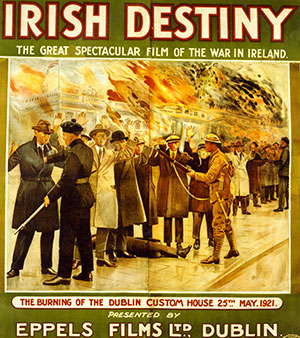Irish Film Institute Irish Film Archive
Published in 20th-century / Contemporary History, Features, Issue 5 (September/October 2017), Volume 25By Fiona Fitzsimons

Above: Poster for Irish Destiny (1926) — one of many in the IFI Irish Film Archive collection. (IFI Irish Film Archive)
The IFI’s founding purpose was to protect the morals of the cinema-going public. The Vigilante Curia warned against the potential influence of immoral films. The Church responded by trying to harness the power of the moving image for itself. Archbishop McQuaid even contributed his own money to buy projectors for the institute. In the 1940s the IFI provided the tools and the training to teach priests, nuns and lay teachers how to project and make films. Consequently, one of the core collections in the IFI Irish Film Archive is the footage shot in the 1940s–60s by these amateur film-makers. They assiduously set out to document what was happening in their own parishes, schools and communities. The films are potentially a resource for family historians and for anyone interested in the local, social and cultural history of Ireland.
The film footage reflects what the people who made it perceived as interesting and relevant. There’s a clear focus on religious ceremonies—Holy Communion, Corpus Christi parades, and other community events where parishioners gathered in groups. Given the role of clergy and religious in education and care, the archive includes footage from schools’ events such as sports days, plays and school outings, as well as some rare institutional footage. The Fr Delaney collection, captured by a parish priest living in Dublin’s north inner city, includes the only known footage from inside the Gloucester Street Magdalene Laundry. This footage is remarkable, and not only because it was ever filmed in the first instance. The young women were clearly familiar with Delaney as their priest, and their behaviour on film appears natural and unconstrained, even playful. The archive contains much material from religious orders, and includes some footage from industrial schools. Currently this material is under embargo, but it has been conserved and accessioned for later generations to comprehend.
The IFI Irish Film Archive contains a range of other collections, including some early films shot by the Kalem company, the first US company to film outside continental America. In the summers of 1910–14 the Kalems made over 30 Irish-themed films on location in Kerry, including The Colleen Bawn and bio-pics of Robert Emmet and Rory O’Moore. The ‘O’Kalems’, as they were dubbed, saw the numbers of homesick Irish immigrants living in America and recognised a business opportunity.
Other collections relevant to family and local historians include some state-sponsored information films—promoting safe cycling, good hygiene and health campaigns (including one with a young Noel Browne in 1948, fronting a TB campaign).
The archive has recently accessioned a range of Irish material from Pathé Newsreels. Every month the archive uploads material to the IFI Player. Digitisation has improved public access to the collections. The IFI Irish Film Archive database is not public, and readers will need to visit the archives to gain access. Visits are by appointment only.
Fiona Fitzsimons is a director of Eneclann, a Trinity campus company, and of findmypast Ireland.
















